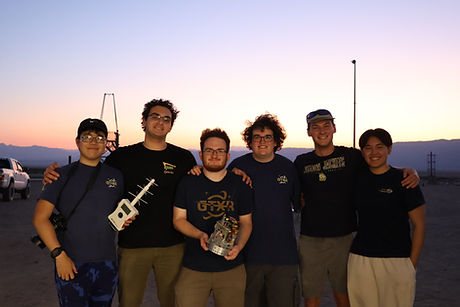
Georgia Tech Experimental Rocketry
A RAMBLIN' ROCKET CLUB PROJECT
Full-Scale Sounding Rockets
The Georgia Tech Experimental Rocketry project is the Ramblin' Rocket Club's initiative to design, build, and launch the first student-led 2-stage rocket to the Kármán Line. Boasting over 100 active members and 7 major launches, GTXR is a great pathway for any aspiring student looking to get hands-on engineering experience on a developed project team.


Propulsion
Student-Researched and Student-Developed Motors
The propulsion team designs, manufactures, and tests a mix of 6'' and 8'' motors that propel GTXR's rockets. The team develops complex nozzle assemblies, motor casings, and ignition systems for a variety of flight conditions. In addition to motor development, the propulsion team also develops and characterizes custom propellant formulas, making variations on the current ammonium-perchlorate-based propellant, which is produced in-house.
Avionics
Flight Computer Development, State Estimation, Telemetry, GPS, Cameras, Mission Control
The Avionics Team is tasked with developing and managing all electronic systems both on the rocket and in mission control. They create and manufacture a custom flight computer made up of multiple printed circuit boards (PCBs), which serves as the rocket's central processing unit. This flight computer gathers data from various parts of the rocket, performs Kalman Filter state estimation, triggers crucial flight events such as staging, sustainer ignition, and parachute deployment, records flight footage with an on-board camera, and transmits telemetry data back to mission control.
Additionally, the Avionics Team designs the auxiliary electronics located in the booster and sustainer bays. They are also responsible for constructing safety and arming mechanisms to ensure the safety of critical personnel during the final launch sequence. Furthermore, they design the mission control interface to facilitate communication with the rocket both on the launch pad and in flight.



Structures
Internal Vehicle Assembly and Composite Aerostructures
The GTXR Structures Team is responsible for designing, manufacturing, and testing all structural and mechanical systems on the rocket. This includes the airframe, fins, and internal structures that interface with the flight avionics and motors. It also includes the rocket's staging system, deployment systems, and parachute and recovery systems.
Simulations
Two-Stage Sounding Rocket Design and Optimization
The simulations team is responsible for determining the high-level design and performance features of GTXR's vehicles, ranging from motor grain geometry to iterative fin design. The team uses a range of vehicle design software and tools, such as RASAero and RocketPy, to create a full-stack optimizer for a two-stage sounding rocket. This software, developed in-house, drives the most important design parameters for overall vehicle design. It also provides predictions of flight performance that are useful for recovery after flight.
.jpg)

Mission Log
Mission | Est Launch | Launch Date |
|---|---|---|
Live and Let Fly | July 2025 | 07/13/2025 |
Strange Magic | Oct 2024 | 10/05/2024 |
Fire on High | July 2024 | 07/13/2024 |
Material Girl | July 2023 | 07/11/2023 |
Mr. Blue Sky | July 2022 | 07/06/2022 |
Rubberband Man | June 2021 | 06/29/2021 |
Sustain Alive | June 2019 | 06/20/2019 |
